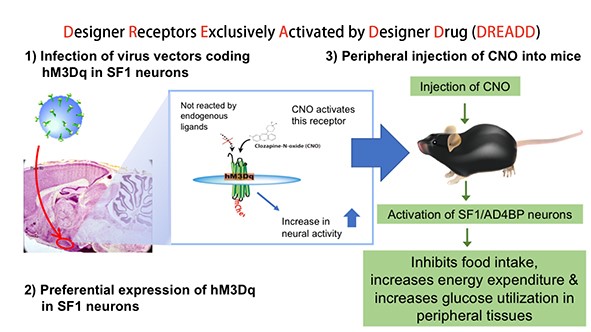An international research team centered at Japan’s National Institute for Physiological Sciences finds that a hypothalamic neuron enhances glucose utilization in peripheral tissues such as skeletal muscles as well as inhibits food intake and increases energy expenditure.
Okazaki, Japan –Type 2 diabetes is one of the fastest growing chronic diseases worldwide. Insulin is responsible to increase glucose utilization in peripheral tissues and maintain blood glucose level. Obesity is well known to induces insulin resistance in peripheral tissues such as skeletal muscle, the most important tissue for glucose utilization in human. Recent studies suggest that in addition to insulin, the central nervous system, especially the hypothalamus, regulates glucose utilization in skeletal muscle via the autonomic nervous system. However, neurons responsible to regulate glucose utilization in skeletal muscle remains unknown.
An international team of researchers centered at the National Institute for Physiological Sciences (NIPS) has identified that specific neurons in the ventromedial hypothalamus called as the SF1/Ad4BP neuron (SF1 neurons) increases glucose utilization in peripheral tissues including skeletal muscle and results in increase in whole-body glucose utilization. The activation of SF1/Ad4BP neuron also inhibits food intake and increases energy expenditure. The findings are to be reported in diabetes, the official journal of the American Diabetes Association.
SF1 neurons in the hypothalamus has been thought to be regulate energy metabolism in mammals. The researcher tested the effects of specific activation of SF1 neurons on food intake, energy expenditure and glucose metabolism in mice by using DREADD (Designer Receptors Exclusively Activated by Designer Drug) technology. A DREADD receptor hM3Dq was expressed in SF1 neurons in mice preferentially, and activated by peripheral administration of drug CNO (Clozapine-N-Oxide). They found that specific activation of SF1 neurons inhibits food intake, increases energy expenditure and enhances glucose utilization in peripheral tissues such as skeletal muscle, heart and thermogenic organ brown adipose tissue. They also found that the increased muscle glucose uptake is mediated by the activation of insulin signaling pathway in the tissue. In contrast, glucose uptake in white adipose tissue, the energy storage tissue, was not increased by activation of SF1 neurons.
The results revealed that activation of SF1 neurons inhibits food intake, increases energy expenditure and enhances glucose utilization in some peripheral tissues. Corresponding author Yasuhiko Minokoshi says, “This study will contribute to the better understanding of the central nervous system control of glucose metabolism, and the novel therapeutic strategy for treatment of type 2 diabetes”.
###
The paper "Activation of SF1 neurons in the ventromedial hypothalamus by DREADD technology increases insulin sensitivity in peripheral tissues” will be published in online version of diabetes at 10 am (east time) on July 3.
Summary Text: A research team centered at Japan’s National Institute for Physiological Sciences identified a hypothalamic neuron that inhibits food intake, increases energy expenditure and increases glucose utilization of peripheral tissues including skeletal muscle but not white adipose tissue.
Keyword: Medicine
Additional keywords: Obesity, Diabetes, Hypothalamus, glucose utilization, skeletal muscle, food intake and energy expenditure.

A group of hypothalamic neurons inhibits food intake, increases energy expenditure and enhances glucose utilization in peripheral tissues. NIPS-led researchers tested the effects of specific activation of SF1 neurons on food intake, energy expenditure and glucose metabolism in mice by using DREADD technology. A DREADD receptor hM3Dq was expressed in SF1 neurons in mice preferentially, and activated by peripheral administration of drug CNO. They found that specific activation of SF1 neurons inhibits food intake, increases energy expenditure and enhances glucose utilization in some peripheral tissues such as skeletal muscle.





National Institute for Physiological Sciences (NIPS)
Hoshi University
Kyushu University
Tokyo Medical and Dental University
Japan Agency for Medical Research and Development (AMED)